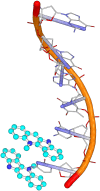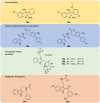Indole: The After Next Scaffold of Antiplasmodial Agents?
- PMID: 33204071
- PMCID: PMC7666986
- DOI: 10.2147/DDDT.S278588
Indole: The After Next Scaffold of Antiplasmodial Agents?
Abstract
Malaria remains a global public health problem due to the uphill fight against the causative Plasmodium parasites that are relentless in developing resistance. Indole-based antiplasmodial compounds are endowed with multiple modes of action, of which inhibition of hemozoin formation is the major mechanism of action reported for compounds such as cryptolepine, flinderoles, and isosungucine. Indole-based compounds exert their potent activity against chloroquine-resistant Plasmodium strains by inhibiting hemozoin formation in a mode of action different from that of chloroquine or through a novel mechanism of action. For example, dysregulating the sodium and osmotic homeostasis of Plasmodium through inhibition of PfATP4 is the novel mechanism of cipargamin. The potential of developing multi-targeted compounds through molecular hybridization ensures the existence of indole-based compounds in the antimalarial pipeline.
Keywords: PfATP4; antimalarial agents; hemozoin inhibition; indole; multi-target approach.
© 2020 Surur et al.
Conflict of interest statement
The authors declare no conflict of interest.
Figures








Similar articles
-
Biochemical characterization and chemical inhibition of PfATP4-associated Na+-ATPase activity in Plasmodium falciparum membranes.J Biol Chem. 2018 Aug 24;293(34):13327-13337. doi: 10.1074/jbc.RA118.003640. Epub 2018 Jul 9. J Biol Chem. 2018. PMID: 29986883 Free PMC article.
-
The malaria parasite cation ATPase PfATP4 and its role in the mechanism of action of a new arsenal of antimalarial drugs.Int J Parasitol Drugs Drug Resist. 2015 Aug 27;5(3):149-62. doi: 10.1016/j.ijpddr.2015.07.001. eCollection 2015 Dec. Int J Parasitol Drugs Drug Resist. 2015. PMID: 26401486 Free PMC article. Review.
-
A G358S mutation in the Plasmodium falciparum Na+ pump PfATP4 confers clinically-relevant resistance to cipargamin.Nat Commun. 2022 Sep 30;13(1):5746. doi: 10.1038/s41467-022-33403-9. Nat Commun. 2022. PMID: 36180431 Free PMC article.
-
Natural Product Inspired Novel Indole based Chiral Scaffold Kills Human Malaria Parasites via Ionic Imbalance Mediated Cell Death.Sci Rep. 2019 Nov 28;9(1):17785. doi: 10.1038/s41598-019-54339-z. Sci Rep. 2019. PMID: 31780808 Free PMC article.
-
Spiroindolone NITD609 is a novel antimalarial drug that targets the P-type ATPase PfATP4.Future Med Chem. 2016;8(2):227-38. doi: 10.4155/fmc.15.177. Epub 2016 Jan 29. Future Med Chem. 2016. PMID: 26824174 Review.
Cited by
-
Potential Plant-Based New Antiplasmodial Agent Used in Papua Island, Indonesia.Plants (Basel). 2023 Apr 28;12(9):1813. doi: 10.3390/plants12091813. Plants (Basel). 2023. PMID: 37176870 Free PMC article. Review.
-
In silico prediction of some pharmacokinetic, safety, biological activity and molecular docking studies of 1-piperazine indole hybrid with nicotinic amide and nicotinic acid and their analogues.SAGE Open Med. 2024 Oct 16;12:20503121241274212. doi: 10.1177/20503121241274212. eCollection 2024. SAGE Open Med. 2024. PMID: 39483628 Free PMC article.
-
Indole-Based Compounds as Potential Drug Candidates for SARS-CoV-2.Molecules. 2023 Sep 13;28(18):6603. doi: 10.3390/molecules28186603. Molecules. 2023. PMID: 37764378 Free PMC article. Review.
-
Recent Progress in Cyclic Aryliodonium Chemistry: Syntheses and Applications.Chem Rev. 2023 Jan 17;123(4):1364-416. doi: 10.1021/acs.chemrev.2c00591. Online ahead of print. Chem Rev. 2023. PMID: 36649301 Free PMC article. Review.
-
Identification of novel compounds with prophylactic activity against hypnozoites using a Plasmodium cynomolgi in vitro model.Antimicrob Agents Chemother. 2025 Aug 6;69(8):e0181224. doi: 10.1128/aac.01812-24. Epub 2025 Jul 17. Antimicrob Agents Chemother. 2025. PMID: 40673760 Free PMC article.
References
-
- World malaria report 2019. 2019. Available from: https://www.who.int/news-room/feature-stories/detail/world-malaria-repor.... Accessed October13, 2020.
-
- World malaria report 2018. 2019. Available from: https://www.mmv.org/newsroom/publications/world-malaria-report-2018. Accessed October13, 2020.
Publication types
MeSH terms
Substances
LinkOut - more resources
Full Text Sources

